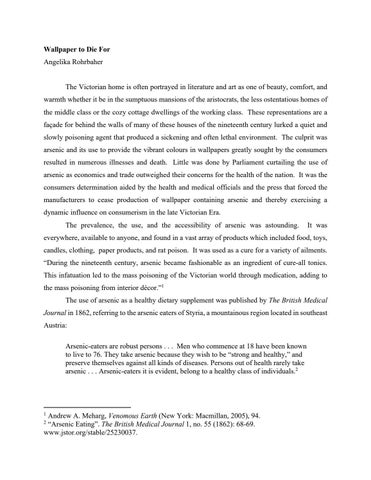Wallpaper to Die For Angelika Rohrbaher The Victorian home is often portrayed in literature and art as one of beauty, comfort, and warmth whether it be in the sumptuous mansions of the aristocrats, the less ostentatious homes of the middle class or the cozy cottage dwellings of the working class. These representations are a façade for behind the walls of many of these houses of the nineteenth century lurked a quiet and slowly poisoning agent that produced a sickening and often lethal environment. The culprit was arsenic and its use to provide the vibrant colours in wallpapers greatly sought by the consumers resulted in numerous illnesses and death. Little was done by Parliament curtailing the use of arsenic as economics and trade outweighed their concerns for the health of the nation. It was the consumers determination aided by the health and medical officials and the press that forced the manufacturers to cease production of wallpaper containing arsenic and thereby exercising a dynamic influence on consumerism in the late Victorian Era. The prevalence, the use, and the accessibility of arsenic was astounding.
It was
everywhere, available to anyone, and found in a vast array of products which included food, toys, candles, clothing, paper products, and rat poison. It was used as a cure for a variety of ailments. “During the nineteenth century, arsenic became fashionable as an ingredient of cure-all tonics. This infatuation led to the mass poisoning of the Victorian world through medication, adding to the mass poisoning from interior décor.”1 The use of arsenic as a healthy dietary supplement was published by The British Medical Journal in 1862, referring to the arsenic eaters of Styria, a mountainous region located in southeast Austria: Arsenic-eaters are robust persons . . . Men who commence at 18 have been known to live to 76. They take arsenic because they wish to be “strong and healthy,” and preserve themselves against all kinds of diseases. Persons out of health rarely take arsenic . . . Arsenic-eaters it is evident, belong to a healthy class of individuals.2
1
Andrew A. Meharg, Venomous Earth (New York: Macmillan, 2005), 94. “Arsenic Eating”. The British Medical Journal 1, no. 55 (1862): 68-69. www.jstor.org/stable/25230037. 2

